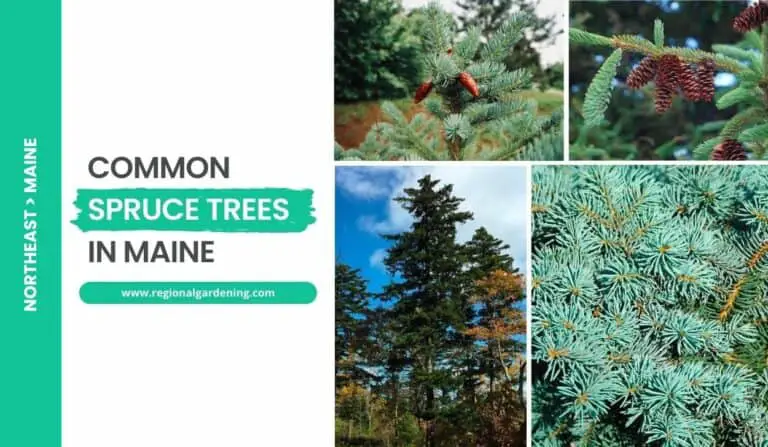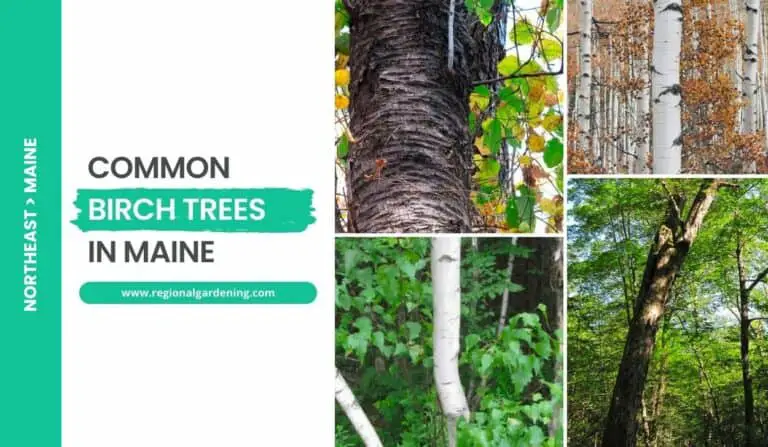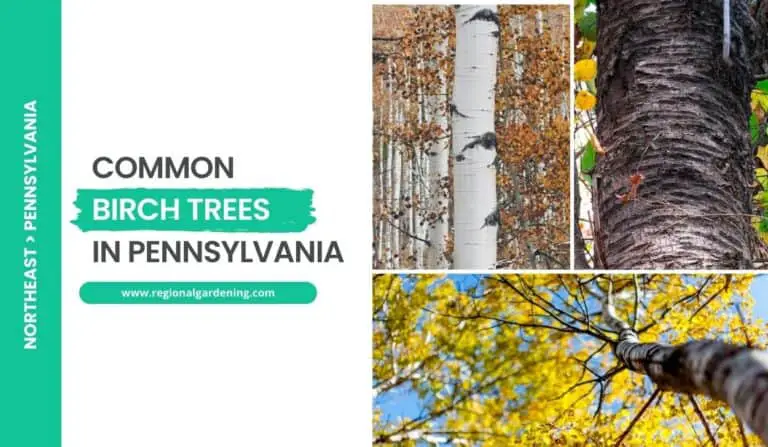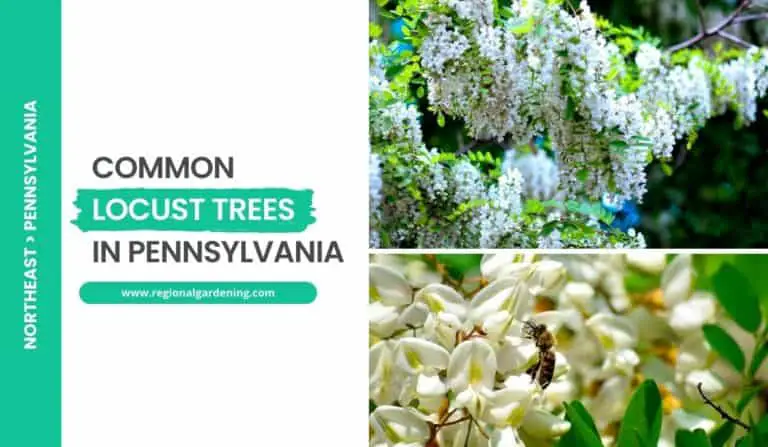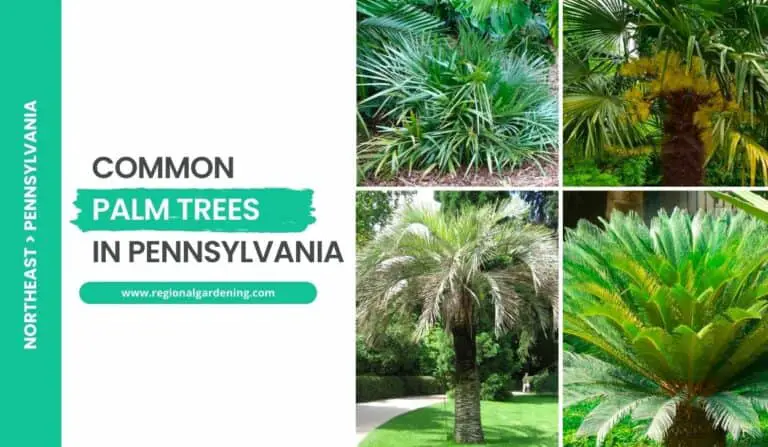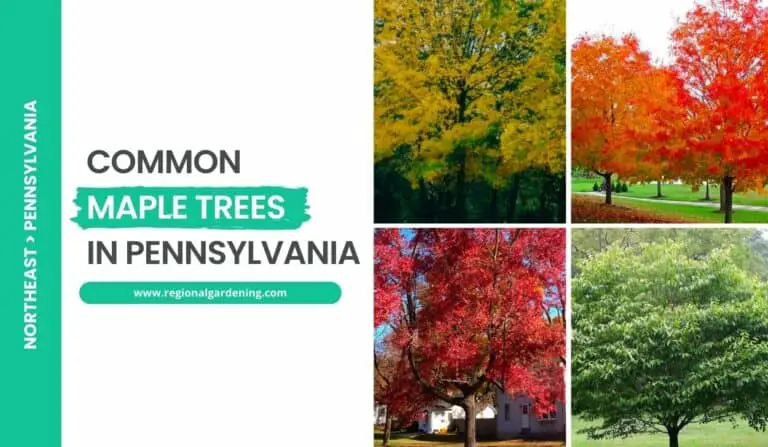3 Native Cherry Trees In Pennsylvania (Photos & Identification)
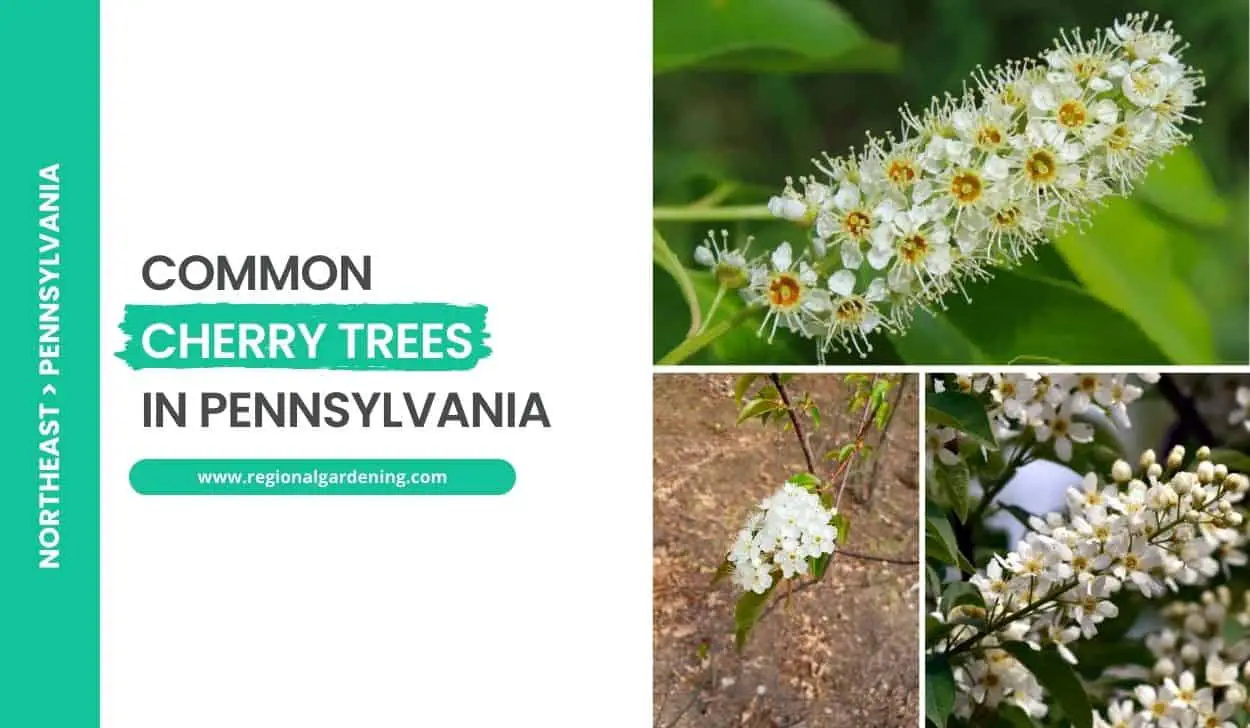
Pennsylvania is home to many beautiful cherry trees that enchant both residents and visitors. Cherry trees in Pennsylvania are a true marvel of nature, with their breathtaking blossoms, delicious cherries, and the delightful wildlife they attract.
This article will look at three common wild cherry tree varieties found in the state, each with its distinct charm and beauty.
Let us begin.
1. Black Cherry
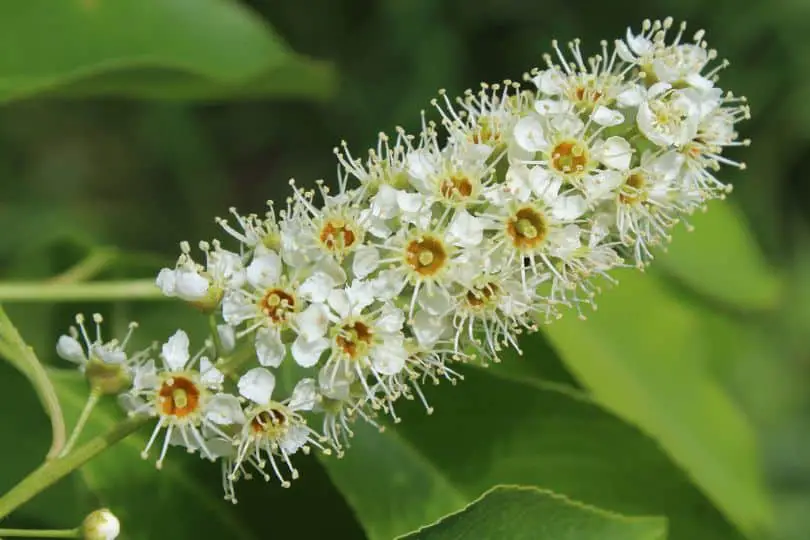
- Scientific Name: Prunus serotina Ehrh.
- Common Name(s): Black Cherry
- Mature Height: 50′-75′ (15-23 meters)
- Native Region: North America
- Flowers: White, in June
- Fruit: Round, black with a purplish tint, ⅓”-½” (0.8-1.3 cm) in diameter, containing a single round, stony seed, arranged in hanging clusters.
- Uses: The hard reddish-brown wood is highly prized for quality furniture and interior trim. Many game birds, songbirds, and mammals, including black bears, eat fruits and seeds.
The black cherry is a medium-sized deciduous tree native to Pennsylvania. It can reach mature heights ranging from 50 to 75 feet (15 to 23 meters). Black Cherry is a North American native that grows best in lush alluvial soil, but it can also grow on dry hillsides.
The tree is distinctive for its alternating, straightforward leaves that are 2 to 5 inches long, thin, and taper at the tip. The upper surface of the leaves is glossy, whilst the lower side is darker and frequently includes one or more tiny glands at the base. The leaf margins contain short in-curved teeth that distinguish it from other cherry tree species.
The twigs of Black Cherry are smooth and reddish-brown, with numerous faint, circular lenticels. They may be covered with a thin gray coating that easily rubs off. The buds are smooth, lustrous, sharply pointed, and reddish-brown with a green tinge.
In June, Black Cherry blooms with white blossoms. The blossoms are clustered and lend a lovely touch to the tree. Black Cherry fruits are spherical, black with a purple tint, and roughly 13 to 12 inches (0.8 to 1.3 cm) in diameter. These fruits are grouped in hanging clusters and contain a single spherical, stony seed.
There are numerous applications for black cherry. Its strong reddish-brown wood is widely sought after for high-end furniture and interior trim. Furthermore, numerous game birds, songbirds, and animals, including black bears, devour the fruits and seeds of the Black Cherry.
Plant Black Cherry in well-drained soils with full sun exposure for optimal care in Pennsylvania settings. During droughts, regular watering is required. To preserve a desirable shape and remove dead or damaged branches, pruning should be done during the dormant season.
It is crucial to note that the Black Cherry leaves and seeds contain cyanide precursors and should be avoided by both cattle and humans. Despite this, the Black Cherry tree is still popular and valued in Pennsylvania gardens.
2. Fire Cherry
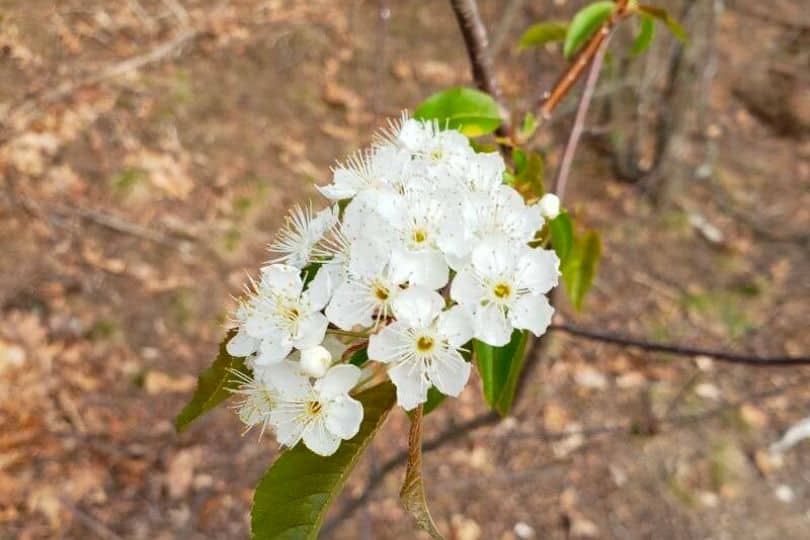
- Scientific Name: Prunus pensylvanica L.f.
- Common Name(s): Fire Cherry, Pin Cherry
- Mature Height: Up to 40 feet (12 meters)
- Native Region: North America (specifically Pennsylvania)
- Flowers: White, approximately ½” across, in flat-topped clusters of 4-5
- Fruit: Juicy, light red drupes, about ¼” in diameter, with sour flesh, maturing in early fall
- Uses: Valuable reforestation species, provides shade for seedlings of other tree species, food source for birds and small mammals, browsed by deer
The Fire Cherry, Prunus pensylvanica, is a tiny tree or shrub that can grow to be up to 40 feet tall. Pin Cherry is another common name for it. This tree is mostly found in Pennsylvania’s mountainous regions, however, it is uncommon in the state’s southeast and southwest.
The Fire Cherry is useful in regeneration efforts, especially after a fire or lumbering has destroyed the soil. It is a pioneer species, which means it was among the first to colonize damaged regions. The thin and flat-topped crown of the tree provides shade for seedlings of other tree species that follow it in succession.
Furthermore, the fruit of the Fire Cherry is an important food source for many birds and small mammals.
The Fire Cherry’s physical traits include alternating, simple leaves that are 3 to 5 inches long. The leaves are broadest below the center, with a tapering or rounded base and sharp-pointed points. The leaf margins are highly serrated, and the leaves are glossy green on both sides.
The Fire Cherry twigs are slim, smooth, and glossy bright red. They may be grayish and contain several faint prominent lenticels that might elongate horizontally. Young trunks have reddish brown bark that is smooth and has big horizontally extended lenticels. The bark of the tree grows roughened but does not crack as it ages. The outer bark peels away in thin film-like layers, exposing the green inner bark.
Because of its brilliant white blossoms that bloom in May, the Fire Cherry can be a visually pleasing addition to Pennsylvania settings. These flowers are approximately 12″ across and come in flat-topped clusters of 4 to 5. The tree yields delicious, light crimson drupes with sour flesh in early fall, adding to its aesthetic appeal.
3. Chokecherry
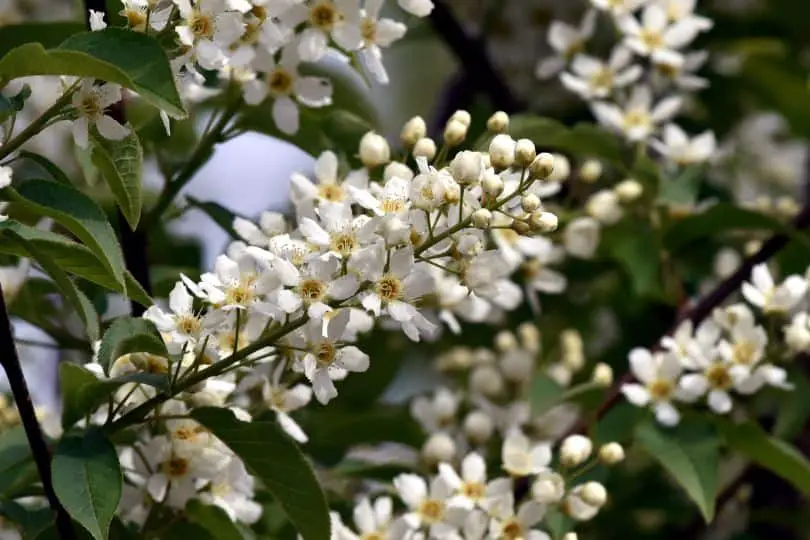
- Scientific Name: Prunus virginiana L.
- Common Name(s): Choke Cherry
- Mature Height: Up to 25 feet (7.6 meters)
- Native Region: North America
- Flowers: White flowers
- Fruit: Dark red to black drupe, about ⅓”-½” in diameter, in elongated, drooping clusters
- Uses: Choke cherries are commonly used for making jams, jellies, sauces, and syrups. The fruit also provides food for birds and mammals.
Choke Cherry (Prunus virginiana L.) is a short-lived, fast-growing shrub or small tree that can grow up to 25 feet tall. It is distributed throughout Pennsylvania in a range of open habitats, thickets, roadsides, and upland woodlands, with a higher abundance in the western counties. Choke cherries, which are native to North America, were among the first species to revert to cleared land.
The choke cherry tree’s leaves are alternating, simple, and bright green on top, with a paler underside. They are 2 to 4 inches long, with strongly serrated margins, and are widest above the center. The twigs are thick and smooth, light brown to reddish brown, with many yellowish lenticels. When bruised, the twigs emit an unpleasant odor.
Choke cherry fruit is a delicious, dark red to black drupe that measures around 13 to 12 inches in diameter. The fruits form open, long, drooping bunches. The fruit has a harsh and astringent flavor. Choke cherries are frequently used in the preparation of jams, jellies, sauces, and syrups. Furthermore, the fruit is an important food source for a variety of birds and mammals.
Choke cherry trees thrive in Pennsylvania landscapes in terms of upkeep. They enjoy full sun to partial shade and may grow in a variety of soil types. Choke cherries are low-maintenance once established, but they may benefit from pruning to preserve shape and manage size. Watering is recommended regularly during dry months, especially during the first year of planting. They are, however, drought-tolerant once established.
Native Cherry Trees In Pennsylvania – Frequently Asked Questions (FAQs)
Let’s go through some of the most commonly asked questions about cherry trees in Pennsylvania.
Are there any wild cherry trees in Pennsylvania?
Yes, there are wild cherry trees in Pennsylvania. The black cherry (Prunus serotina), which is native to eastern North America, is most likely the most common species of wild cherry tree in the state. These trees are commonly found in forests and woodlands across the state. Wild cherry trees can also be found in other parts of Pennsylvania, such as the Allegheny National Forest.
Apart from black cherry, fire cherry, and chokecherry are the other two commonly found cherry trees in Pennsylvania.
What are some of the uses of wild cherry trees in Pennsylvania?
There are several uses for wild cherry trees in Pennsylvania. Their timber is an important use, as the wood of the black cherry tree is highly valued for its durability and attractive grain. It is commonly used in the construction of furniture, cabinets, and other woodworking projects.
The bark and leaves of the wild cherry tree also have medicinal properties and have traditionally been used to treat coughs, colds, and digestive issues. While the fruit of the wild cherry tree is not commonly consumed by humans, it is consumed by a variety of wildlife species, providing both food and habitat.
Furthermore, wild cherry trees are valued for their ornamental beauty, with white spring blossoms and vibrant fall foliage. They are frequently used in landscaping to improve the appearance of gardens and streetscapes.
Similar Articles
- Common Flowering Trees In Pennsylvania
- Common Maple Trees In Pennsylvania
- Common Pine Trees In Pennsylvania
- Common Locust Trees In Pennsylvania
- Common Nut Trees In Pennsylvania
- Common Cedar Trees In Pennsylvania
- Common Palm Trees In Pennsylvania
- Common Birch Trees In Pennsylvania
- Common Aspen Trees In Pennsylvania
- Common Oak Trees In Pennsylvania
- Common Ash Trees In Pennsylvania
- Common Elm Trees In Pennsylvania
- Common Spruce Trees In Pennsylvania
- Pink Flowering Trees In Pennsylvania
- White Flowering Trees In Pennsylvania
- Purple Flowering Trees In Pennsylvania
Sources
The Regional Gardening team makes sure that the information in our articles is accurate by only using sources that are known to be trustworthy. Some of these sources are peer-reviewed journals from government agencies, well-known universities, and scientific research organizations.
- Native Plant Resources, Pennsylvania Native Plant Society
- Trees & Shrubs Varieties, PennState Extension
- Landscaping With Natives, Pennsylvania Department Of Conservation, & Natural Resources.
- Explore Pennsylvania Forests, Pennsylvania Department Of Conservation, & Natural Resources.


